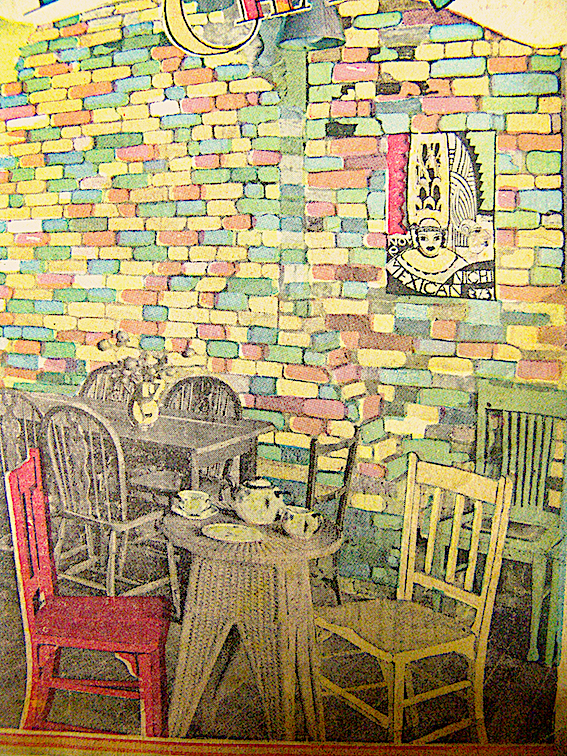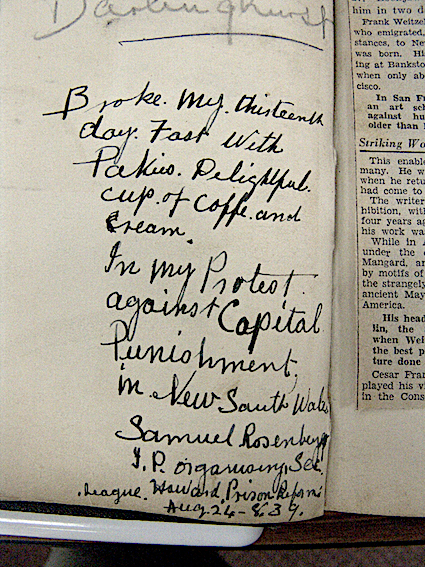The club for “bohemians”
There’s nothing else like Pakie’s. Everybody’s said to come here, and you’re certain to be seen here. Unknowns of all pretensions, but also local lionesses, Dulcie D. and Kylie T. and Bea, and young musicians from the Con, professors from the University, familiar voices from the ABC … and spies. [RED, page 28]
From 1929 until the 1960s, “Pakie’s Club was a centre for bohemians, artists and intellectuals (including, … scientists like the geologist Oliver Chalmers). It flourished at a time when the cultural life of Sydney was quiescent and conservative. The live theatre and the cinema were both foreign dominated, radio was in its infancy, and publication of the work of Australian writers was at a low ebb.”
Augusta Macdougall, who founded Pakie’s, “was to Sydney in many ways what Gertrude Stein was to Paris. She ran a salon in her own style,” writes her grandson, Ian Macdougall, in a note among the Club’s documents in the National Library (NLA). “Pakie” was Augusta Macdougall’s nickname.
Photographs of the café show a different mood from the staid, gloomy, brown-varnished restaurants typical of the 1930s. The furnishings were cheap and hand-made, using block-printed fabrics; and the walls, tables and chairs were painted in strong primary colours (under the guidance of Roy de Maistre).

A corner of Pakie’s Club. The poster on the wall is for one of the Club’s monthly “international” nights.
When this photograph was used in a magazine article, it was coloured to suggest how the bricks and furniture were painted.

Signatures in the Club’s guest book show that Pakie’s was regularly visited by well-known writers, actors, musicians and artists of the time, including Bartlett Adamson, Dymphna Cusack, Eleanor Dark, Dulcie Deamer, Jean Devanny, George Finey, Miles Franklin, Mary Gilmore, Xavier Herbert, Bernard Hesling, Jack Lindsay, Roy de Maistre, Katharine Susannah Pritchard and Kylie Tennant. Overseas visitors were generous: “La maison Pakies,” says one, is “un coin de France à 20.000 kilomètres.”

One of many well-known guests, Katharine Susannah Prichard (1935)
By 1934 the Club offered weekly talks, plays and other events. Both progressives and conservatives gave these presentations. The reactionary art critic J. S. MacDonald spoke against “modern art”, but his attitude wasn’t typical of the Club; most speakers at Pakie’s preferred to “explain” modernism. One speaker praised the poetry of D. H. Lawrence (some of whose books were banned at the time) and Mary Gilmore gave “an address on the New Australia colony in Paraguay”.
There were talks on “the Woman in Russia, yesterday today and tomorrow”, “The evolution of Mind and personal influence”, “Negro music and its influence on world culture”, and an account of how movies were made (given by Charles Chauvel). In 1936 the fascist P. R. Stephensen spoke on “Culture in Australia”, while later that year there was a debate on Communism.

Caricature of a Pakie’s regular by ‘Hotpoint’ Lahm in the Club’s broadsheet
The Club’s members produced a broadsheet that was passed around the café’s tables. Typewritten items were pasted beside caricatures of members and regulars. The magazine was “a true journal of the 1930s depression, produced through its darkest years,” Ian Macdougall explains. “The copy for each issue, once typed, was pasted onto cartridge paper to enhance its durability, and then passed from hand to hand among the members and habitués of the club. The issues are all well thumbed, and a number are missing. …” (From Ian Macdougall’s notes to the surviving issues of the broadsheet, Urge, now in the NLA, Bib ID 1420498)
The magazine raged against Australia’s banning of books, such as Aldous Huxley’s Brave New World and Ernest Hemingway’s A Farewell to Arms. These novels were suppressed by the Customs Department, whose minister said, after a further four years of controversy, that if the ban was removed the books “would receive an undesirably wide demand in Australia.” (Sydney Morning Herald, 26-03-37). Almost as controversial in provincial Sydney were the plays of George Bernard Shaw, defended in one piece in the Club’s broadsheet as “a better thinker and endowed with a finer sense of social justice than Shakespeare.”
The paper’s editor, Leon Batt, was anti-fascist at a time when many influential Australians, such as the Attorney-General, Robert Gordon Menzies, found Hitler and Mussolini admirable examples for Australians to follow. Political articles included “Who burned the Reichstag?” by Brian Penton and “The Sacco and Vanzetti case. Its true history” (unsigned).
Religion was often pilloried, and traditional philosophy questioned, as in this exasperated satire on the followers of Descartes and Plato:

The “habitués” of Pakie’s Club were “making their own entertainment and art,” Ian Macdougall suggests. “In this they anticipated the cultural pursuits, to come soon enough, of the inmates of the [prisoner-of-war] camps of World War 2.” (When I asked Ian why he thought Pakie’s reminded him of POW camps, he said that both the artists and the prisoners had to make their lives and happiness “out of nothing. It was the poverty.”)
And how many clubs in 1930s Sydney would honour a protestor against the hanging of a murderer? The next item comes from the Club’s guest book, known as the Book of Words. After a two-week hunger strike over the hanging of John Kelly in 1939, the activist Samuel Rosenberg of the Howard Prison Reform League was welcomed at Pakie’s Club:

Pakie was my grandmother’s aunt by marriage. i love her story. what a wonderful woman she was, someone to live up to. From the suffragette movement in London, the NY theatre and Australian theatre and of course Pakie’s cafe. Your article put me in the chair at the cafe watching the interesting people and hearing their opinions and hopes for a better future. Thank you. Sue
LikeLike